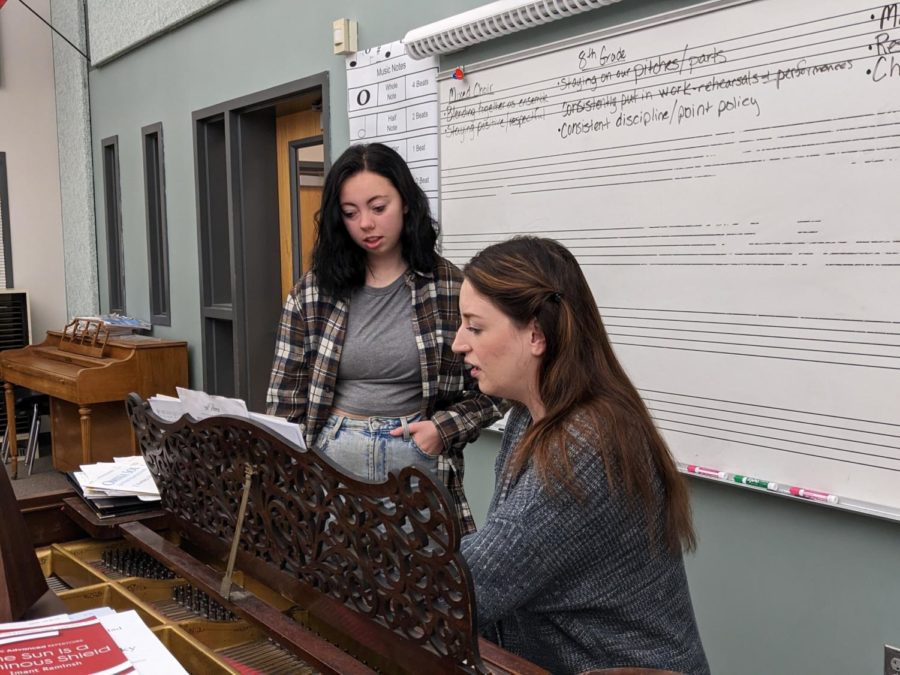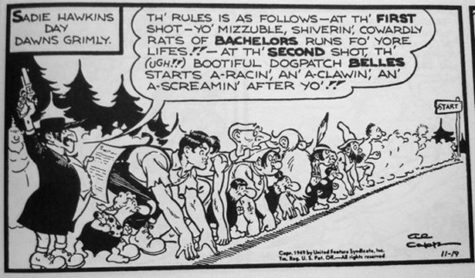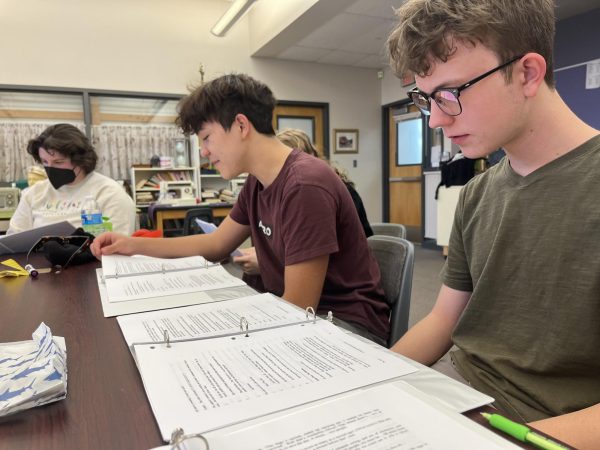Review: “Badger”, Fall Play
November 14, 2019
The crowd was deadly quiet as Rose (Olive Van Eimeren, 10) touchingly embraced the ghost of her lost love Timothy (Matt Buchenhain, 12) after learning of his death in a factory accident the day after Timothy had asked her to run away with him. This year’s performance of the Fall Play, “Badger” by Don Zolidis, was filled with many touching moments between characters, instilling the audience with emotion and connecting them to the story.
“Badger” is a touching romance combining love with the struggles of feminism during WWII. It follows the story of five women who work in a factory that produces gunpowder for the WWII effort. The story arc follows the women through their relationships both in and out of the factory. The dynamic personalities of each of the women made for a well-developed and engaging plot that progressed throughout the play, keeping the audience on the edge of their seats.
For a play taking place in an earlier generation, the cast and directors of “Badger” did an excellent job interpreting the finer nuances of the dated play details, bringing the time, place and atmosphere of the 1940s to the audience with impressive accuracy. As is also on par for Manitou performances, the set allowed the actors to interact only as needed, causing no detracting from the characters’ interactions. Director Wendy Harms’s theater class did an excellent job minimizing costs while maximizing utilization, creating low-budget sets that offer just enough space for the characters to be comfortable in the space and allow the audience’s imagination to fill in the gaps.
Traditionally, the use of such sets that provide minimum interaction for the characters is compensated for by the excellent character development. For “Badger”, Harms worked with MSHS alumnus James Reiter who returned as a director to create an excellent characterization of the workers in the play. Reiter worked closely with the cast to develop individual personalities, creating very real and relatable characters that the audience easily connected with.
While the praises of Manitou’s theatrical abilities and techniques could be sung until the end of time, it is necessary to reflect upon those aspects of the performance that were less than stellar. A clear trend haunted almost all of the actors throughout the performance: enunciation. There was a lack of enunciation with many of the actors which, unfortunately, inhibited the clear delivery of lines. Many times throughout “Badger”, the subject or purpose in a character’s lines was lost due to poor enunciation. Since characterization was such an integral part of the performance, proper enunciation was key in creating a full and effective production. Hopefully, future productions will be able to smooth out the rough edges of this particular issue. But we have to cut the cast some slack, the rest of the play was phenomenal.
“Badger” was certainly a spectacular performance, thanks to lots of work put in by both actors and directors. We should not neglect recognition also of the unsung heroes of the production: the stage manager, lighting designer, sound technician, costume designer and ensemble. Without them, the spectacular performances put on at Manitou’s district auditorium would have been impossible.























































Riley Jungbauer • Feb 19, 2020 at 11:55 am
The description of the play brought a brief image to my imagination. I wasn’t able to catch the play but reading it over was enough to have an understanding of what occurred and the few members of the cast. I hope to be able to come through to the next play to really get a good understanding and be able to live in the moment. I haven’t been to many plays during my high school years but it always is a good time to get out and about and enjoy school spirit. It catches my attention of what play they tried to capture and relieve in their acting roles. I have respect and think that acting is a very neat skill to try and practice during high school to figure out if you enjoy it for the long run.